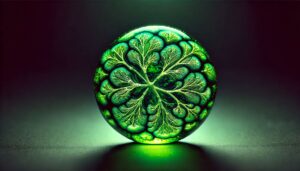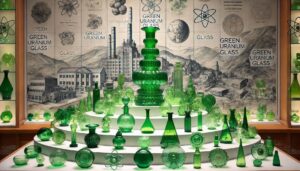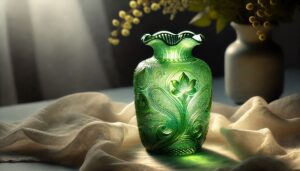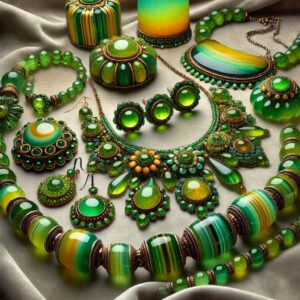In today’s world, there are many things about which we don’t know or have very less information. In this post, we are going to know about such a thing which is known as “Uranium Glass”. People often called it as a magical glass or glowing glass because it’s color is green.

Introduction
It is a type of glass that contains small amount of uranium oxide, due to this composition it glow under ultraviolet(UV) light and also known as “Vaseline Glass” because of its yellow-green color. This uniqueness has attracted collectors and glass enthusiasts for over a century. It is different from other glass because when it is placed under UV light it emits a vibrant neon green glow, which also makes it popular as a decorative item or for collections.

History
It was mainly produced in 19th and early 20th centuries and became popular during a time when glassmakers try new things to create unique colors and effects. One of the earliest records of it’s production was in the 1830s in Germany. Initially, they were not aware of it’s radioactive properties and appreciated its bright color and glow which made it unique as compared to other glass. It was mainly used in a variety of household items like dishes, jewelry and even as decorative items.

In the early to mid-20th century it was at it’s peak popularity, especially during the Art Deco movement of the 1920s and 1930s. During this time glassware became more accessible and this glass was made into everyday items like cups, plates and even bowls.
The production of vaseline glass was stopped in the 1940s due to increased uses of uranium during World War II. Uranium was used in military and energy applications due to which this glass became more scarce and it’s production was limited.

Formation
It has distinctive characteristics specially it’s neon green glow under UV light only because of its composition. The uranium used in nuclear reactors and weapons is highly enriched where as in uranium glass it is in the form of uranium dioxide (UO₂) and is present in low concentration, generally between 2% and 25% by weight. This composition is sufficient to create the effects that make uranium glass so unique or emits very low radiation that is very less harmful to humans.
Apart from uranium, the composition of uranium glass includes glass making ingredients such as silica (it is the main component of glass), sodium carbonate (soda), calcium oxide (lime) and other materials that increase the glass durability, texture and transparency. In some cases, coloring agents also added to enhance or modify its yellow green color produced by uranium.

The glow of uranium glass under UV light is depend on its composition, if the uranium content is higher it will glow more under ultraviolet (UV) light.
Lower concentration around 2-5% produce faded yellow-green glass with a softer glow under UV light.
Higher concentration around 20-25% produce more vibrant green glass and more effect under UV light.
Use of Uranium Glass
Due to unique color and glow of uranium glass it is used to make a wide variety of products like household good, decorative and ornamental pieces. During its peak popularity in 19th and early 20th centuries, uranium glass was used in homes decorative collections. Some of it’s common uses.

Uranium glass was commonly used to make dinner plates, tea cups, saucers and bowls. The vibrant color of uranium glass gives uniqueness to table settings and also glow when kept in UV light giving almost magical effect. These Items were popular in the Victorian and Art Deco periods when luxurious tableware was highly valued.
It was also used to make ornaments and beautiful jewelries which has a magical glow when move to UV light and also used to gain attention of people.

Is uranium glass safe to use?
Uranium glass contains uranium that is why it emit radiation but these levels are very low to cause any health risk to humans. The uranium used in uranium glass is generally about 2-25% in the form of uranium dioxide and it is very low compared to uranium used in nuclear reactors and weaponry.
Types of radiation emitted
Uranium glass primarily emits alpha radiation due to the presence of uranium content. It also emit beta and gamma radiation.
- Alpha Radiation: It is the main type of radiation emitted by uranium in uranium glass. Alpha particle have very low penetration ability and it cannot pass through glass surface or human skin.
- Beta Radiation: Small amount of beta particles are also emitted but it has limited penetration ability so standard glass thickness usually absorbs the beta radiation and it doesn’t reach beyond the surface.
- Gamma Radiation: It is the most penetrating form of radiation but uranium glass emits very low amount of gamma radiation so, it is not harmful to humans even at close range.
To understand more about how much uranium glass is safe let’s compare it’s radiation level with everyday objects and environment:
Uranium glass emits radiation which is equal to or even less than the radiation of sun in many areas. It’s radiation is also lower than the daily use household items like granite countertops, ceramic tiles and smoke detectors. Even certain foods such as bananas and Brazil nuts contain small amount of radioactive isotopes like potassium-40 and radium which expose us to more radiation than handling uranium glass.
Precautions
Uranium glass is generally safe but still some collectors take basic precautions, such as:
- It is best to avoid the use of uranium glass for food or drink.
- Broken uranium glass should be handled carefully.
- It can be stored in well-ventilated areas which can minimize the release of extremely low levels of radon gas, although it is generally negligible.

Uranium glass contains small amount of uranium and emits minimal levels of radiation so, it is generally considered as safe for display and handling. Its unique beauty, special glow and historical significance make it a fascinating piece for collectors and enthusiasts. By understanding the myths and facts about uranium glass, collectors can enjoy these pieces after knowing it doesn’t pose any real risk to health when handled responsibly. With just a few precautions you can continue to appreciate the beauty of uranium glass by adding it to your collection.

Lovely just what I was searching for.Thanks to the author for taking his time on this one.